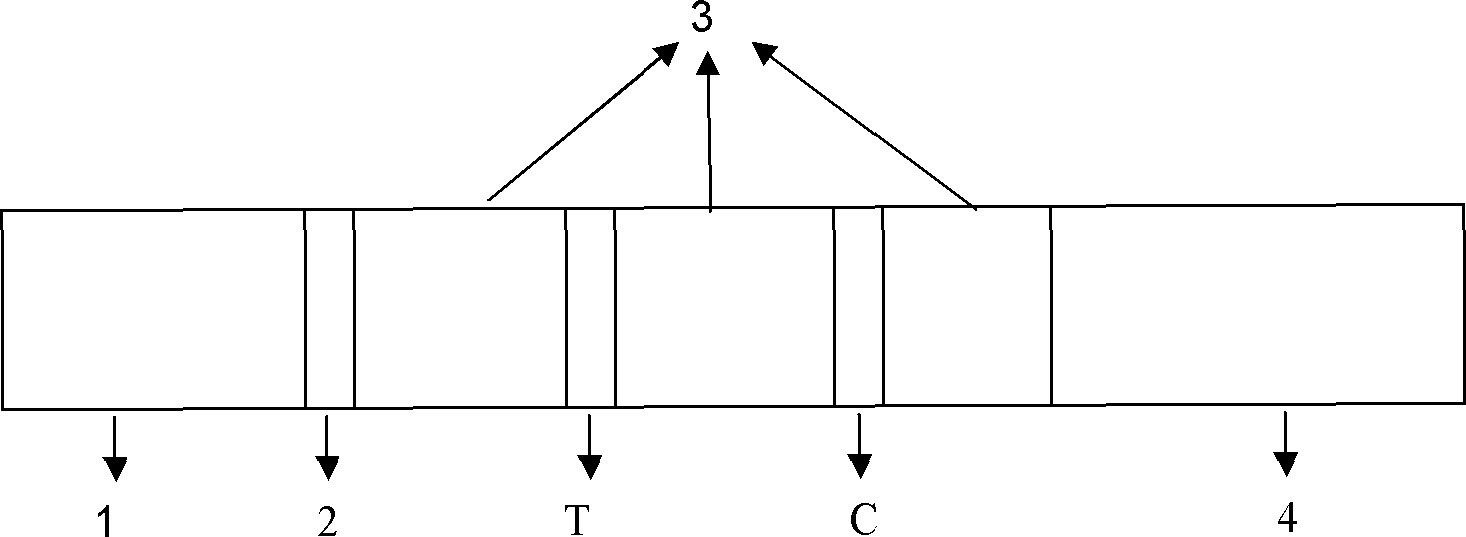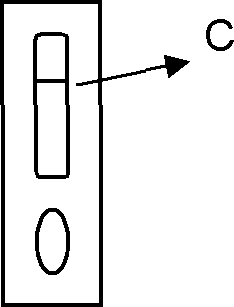Ketamine-collaurum test paper for detection of saliva
A saliva detection and ketamine technology, applied in biological testing, measuring devices, material testing products, etc., can solve problems such as adulteration, cross-over problems, inapplicability, etc., and achieve the effect of clear and easy identification, improved sensitivity, and easy promotion.
- Summary
- Abstract
- Description
- Claims
- Application Information
AI Technical Summary
Problems solved by technology
Method used
Image
Examples
Embodiment 1
[0049] The preparation of embodiment 1 ketamine colloidal gold detection test strip (referring to Fig. 1)
[0050] 1. Preparation of colloidal gold:
[0051] Accurately measure 100mL of purified water, put it into a round bottom flask, heat and stir until boiling. Add 2mL of 1% chloroauric acid solution into boiling water, continue heating and stirring. When the solution boils again, accurately measure 2 mL of 1.0% trisodium citrate solution and quickly add it to the solution, and continue to boil. Carefully observe the color of the solution. When the solution turns from yellow to purple-black, and finally becomes stable to wine red, start timing and continue heating for 10 minutes. After the temperature of the solution returns to room temperature, stop stirring, restore the volume to 100 mL with purified water, and store at 4°C in the dark for future use.
[0052] 2. Preparation of ketamine monoclonal antibody gold label pad
[0053] 2.1 The required raw material ketamine...
Embodiment 2
[0073] The preparation of embodiment 2 ketamine colloidal gold detection test strips
[0074] 1. Preparation of colloidal gold:
[0075] Accurately measure 100mL of purified water, put it into a round bottom flask, heat and stir until boiling. Add 2mL of 1% chloroauric acid solution into boiling water, continue heating and stirring. When the solution boils again, accurately measure 2 mL of 1.0% trisodium citrate solution and quickly add it to the solution, and continue to boil. Carefully observe the color of the solution. When the solution turns from yellow to purple-black, and finally becomes stable to wine red, start timing and continue heating for 10 minutes. After the temperature of the solution returns to room temperature, stop stirring, restore the volume to 100 mL with purified water, and store at 4°C in the dark for future use.
[0076] 2. Preparation of ketamine monoclonal antibody gold label pad
[0077] 2.1 Required raw materials
[0078] Ketamine monoclonal anti...
Embodiment 3
[0093] Embodiment 3 detection method (referring to Fig. 2)
[0094] Spit or drop the saliva of the specimen to be tested directly into the test strip sample loading area or saliva collection device prepared in Example 1 and Example 2, the sample liquid moves forward along the membrane by capillary action, within 3-5 minutes Interpretation results, if more than 10 minutes, the results are invalid.
[0095] Result: If the sample contains ketamine (positive), a red band appears at the quality control line C, and there is no band at the reaction line T.
[0096] If there is no ketamine (negative) in the sample, there will be a band at the quality control line C and the reaction line T respectively, and there will be two bands in total.
[0097] The test results form a band at "C" regardless of whether ketamine is present in the specimen. This line is a quality control line. If the colloidal gold fails, this line will not appear, indicating that the test strip is invalid.
PUM
| Property | Measurement | Unit |
|---|---|---|
| Sensitivity | aaaaa | aaaaa |
Abstract
Description
Claims
Application Information
 Login to View More
Login to View More - R&D
- Intellectual Property
- Life Sciences
- Materials
- Tech Scout
- Unparalleled Data Quality
- Higher Quality Content
- 60% Fewer Hallucinations
Browse by: Latest US Patents, China's latest patents, Technical Efficacy Thesaurus, Application Domain, Technology Topic, Popular Technical Reports.
© 2025 PatSnap. All rights reserved.Legal|Privacy policy|Modern Slavery Act Transparency Statement|Sitemap|About US| Contact US: help@patsnap.com



